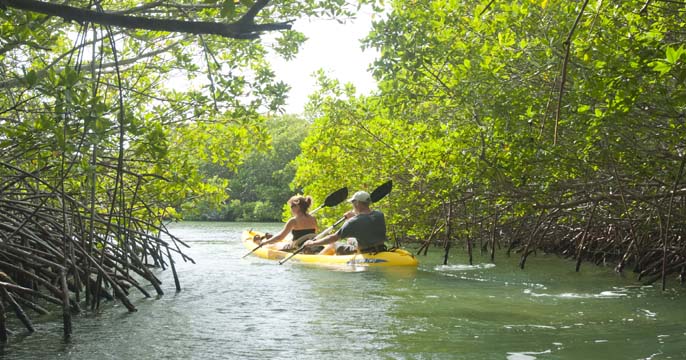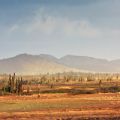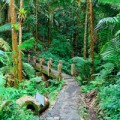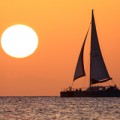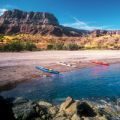Diving may be the island’s number one draw, but there’s a lot more to see and do on Bonaire, both on land and on the water.
You’ll see a lot of dive gear coming out of baggage claim at Bonaire’s airport, and all along the coastal road, pickups loaded with scuba tanks sit parked near favorite shore-entry points. Even the license plates proclaim “Divers Paradise.” But what if you don’t have the urge to submerge? Or are looking for something to do after touring the reefs? Sure, you can choose a beach lounge and a cool drink, but don’t settle in just yet, because adventure awaits.
Windsurfing
Neighboring Aruba was the first Caribbean island to become a windsurfing hot spot. But much of the action has shifted to Bonaire, where the waters of Lac Bay are swept by easterly trades, but protected from pounding surf. The epicenter of sailing action is Jibe City, where first-timers just learning to water start can mingle with some of the world’s best freestyle riders.
Kiteboarding
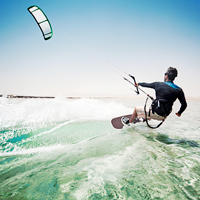
Kiteboarding along Bonaire’s southwestern coastline. Photo: iStock
Bonaire’s strong, steady trade winds are ideal for the high-flying sport of kiteboarding. The hot spot for kiting is along the island’s southwestern shore at Atlantis Beach. Offshore winds and calm near-shore waters allow beginners to practice their starts without fear of being driven onto a lee shore, while experts stage screaming exhibition reaches and high-flying tricks within camera distance of the beach’s iconic surf shack.
Hiking
The best hiking in Bonaire’s arid interior is at Washington Slagbaai National Park, which covers the entire northern end of the island. The two-mile climb up Mount Brandeis begins with a well-worn path, but ends as a scramble over boulders for a dramatic, wind-swept view of the island. At 780 feet, it’s the island’s tallest point. There are several other less taxing but equally memorable hiking paths in the park, including a coastal trail that leads to a spouting blow hole on surf-washed windward cliffs.
Stand-Up Paddleboarding
The SUP craze hasn’t missed Bonaire, and two of the island’s early adopters, Roan Jaspars and Frederick Vloeberghs now offer rentals, lessons and guided tours at SUP Bonaire. If you are paddling on Lac Bay, you can avoid the wind by plying the sheltered mangrove channels. But more often, tours and lessons launch from the calmer western shoreline, where you can enjoy solitude down by the Slave Huts or tour Kralendijk’s waterfront. On lighter wind days, the duo will lead trips across the channel to uninhabited Kline Bonaire.
Birding
No visitor to Bonaire should miss a chance to watch the pink flamingos wade in the shallows of Goto Lake or the Pekelmeer salt pans. If you are really into species identification, you can delve deeper by seeking out the more than 200 types of sea, shore and land birds that either call the island home or stop by during annual migrations. Local ornithologist Jerry Ligon leads tours for both novice watchers and avid ornithologists.
Bicycling
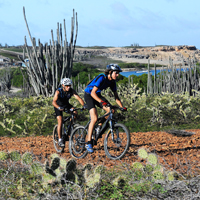
Bonaire’s Washington-Slagbaai National Park provides miles of dirt roads and challenging terrain. Photo: Debbie Snow
Bonaire offers something for all breeds of pedal-pushers. Caribbean Sports rents classic Dutch-style urban cycles for casual rides around town, or mountain bikes that are ready to take on the island’s challenging single track. For an adventurous but still comfortable in-between, head to Washington Slagbaai National Park for a day of cycling the unpaved loop road, with stops at some of the hidden coves and beaches.
Kayaking
Paddling excursions can be launched from most any place on the island’s western shore, and “kayak snorkeling” with clear-bottomed boats provides a different twist on a shoreline tour. The island’s favorite paddling adventure takes place in the mangrove channels in the northern end of Lac Bay, where nature tours begin at the Mangrove Information Center and wind through narrow, shaded waterways before emerging into the bright sunshine of the bay.
Caving
Bonaire’s limestone substrate is riddled with caves. But visits to these subterranean chambers require one to engage in “wild caving,” meaning no handrails, footpaths or built-in lighting. If you are in reasonable physical shape and don’t mind getting a bit dirty, this might be for you. One signature cave tour includes an underground snorkel trip in a clear-water pool.
Fishing
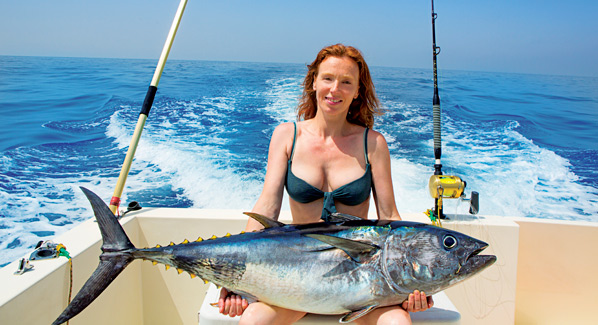
Yellowfin tuna are just one of the gamefish caught in the blue water that run close to Bonaire’s coast. Photo: Tom Balaguer / iStock
The blue waters surrounding Bonaire are fertile ground for a big game- fishing trip. For more than three decades, the man to charter for an angling success has been Capt. Chris Morkos. Whether it’s trolling for billfish and mahimahi, light-tackle plugging on the reefs or bottom fishing, his 42-foot twin-engine Piscatur is equal to the mission. For inshore action, Morkos can also set you up for catching outsized bonefish and permit on the flats.
Sailing
A day sail is a great way to see Bonaire’s coastline, hop over to Kline Bonaire or stage a longer voyage to visit the northern coves of the national park. The sailing catamaran Mushi Mushi is a good choice; its twin hull configuration is both stable and spacious. Even landlubbers can enjoy these passages because the sailing is done on the calmer, protected waters along the island’s west coast. Sunset sails are also a popular option.

